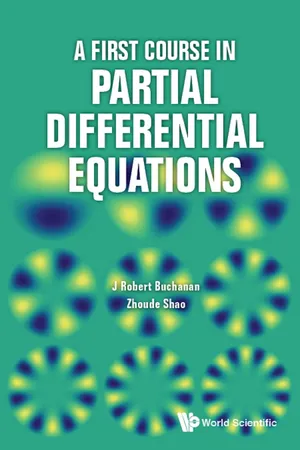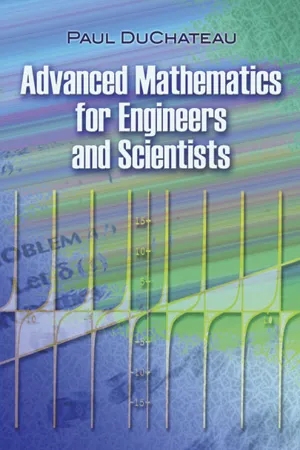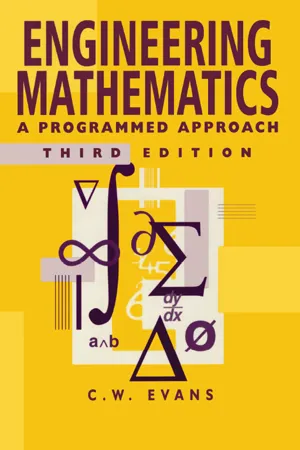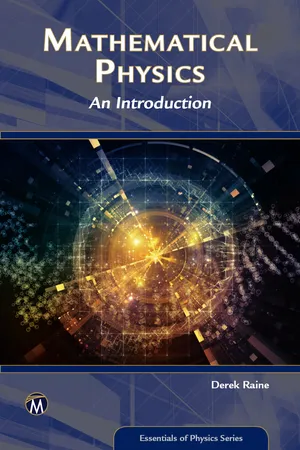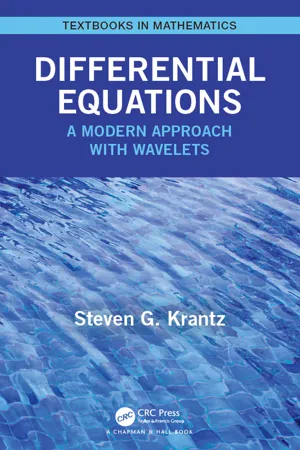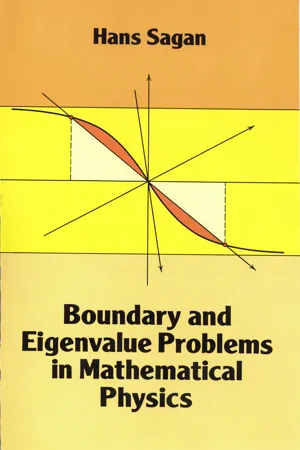Technology & Engineering
Fourier Series Odd and Even
Fourier series odd and even refer to the decomposition of a periodic function into a sum of sine and cosine functions. A function is said to be even if it is symmetric about the y-axis, and odd if it is symmetric about the origin. By decomposing a function into its odd and even components, it becomes easier to analyze and manipulate the function using Fourier series.
Written by Perlego with AI-assistance
Related key terms
Related key terms
1 of 4
Related key terms
1 of 3
11 Key excerpts on "Fourier Series Odd and Even"
- eBook - ePub
- J Robert Buchanan, Zhoude Shao(Authors)
- 2017(Publication Date)
- WSPC(Publisher)
n is an even integer are nonzero. There remain two Fourier coefficients to calculate.Therefore the Fourier series of f(x) can be expressed asExample 3.4. Find the Fourier series representation of g(x) = | sin x | on [−π, π].Solution. Let f(x) be the function defined in Example 3.3, then the reader can verify thatSince the Fourier series representation of sin x is just sin x itself, the Fourier series of g(x) is3.4Even and Odd Functions
The Fourier series for functions possessing certain symmetry properties can be simplified. In this section, the Fourier series of even and odd functions are discussed.The reader should first recall that a function f(x) is said to be even if, for any x in its domain, −x is in its domain and f(−x) = f(x) for all such x. A function f(x) is odd, if f(−x) = −f(x) for all real numbers x such that x and −x are in the domain of f. Note that, for any given function f(x) defined on (−∞, ∞), f(x) can be written as the sum of an even function and an odd function. In fact,where (f(x) + f(−x))/2 is even (sometimes called the even part of f) and (f(x) − f(−x))/2 is odd (likewise called the odd part of f). The following are some basic properties of even and odd functions.•The graph of an even function is symmetric about the y-axis and the graph of an odd function is symmetric about the origin.•If f(x) is odd and f(0) is defined, then f(0) = 0.•If f(x) and g(x) are both even functions, then so are f(x) ± g(x), f(x) ⋅ g(x), and f(x)/g(x).•If f(x) and g(x) are both odd functions, then f(x) ± g(x) is odd, and f(x) ⋅ g(x) and f(x)/g(x - Paul DuChateau(Author)
- 2013(Publication Date)
- Dover Publications(Publisher)
x ).Even and Odd Functions
Note that for each integer n ,A function ƒ (x ) is said to be even if ƒ (x ) = ƒ (−x ), and if ƒ (x ) = −ƒ (−x ), then f is said to be odd . Most functions are neither even nor odd, but any function can be written as the sum of an even function plus an odd function by writingThat is, andHere f E and f 0 denote, respectively, the even part and odd part of f (x ). If f (x ) is even, then f (x ) = f E (x ) and f 0 (x ) = 0. If f (x ) is an odd function, then f (x ) = f 0 (x ) and f E (x ) = 0. In particular, if we havethen since cos(nπx/L ) is even for every n and sin(nπx/L ) is odd for each n , it follows that(7.4)and(7.5)for ƒ (x ) even:(7.6)for f (x ) odd:(7.7)SYMMETRIES
When a function f (x ) defined on [−L, L ] is even, then it is symmetric about the vertical axis and it follows, without need for any computation, that b m = 0 for every m . Similarly, when f (x ) is odd, then it (or more precisely, its graph) is symmetric about the origin and it follows that a m = 0 for every m . Other types of symmetry lead to the vanishing of additional Fourier coefficients. Some of these symmetries are explored in the solved problems.Half Range Series
We may also apply the preceding remarks regarding odd and even functions to the situation in which f (x ) is defined only on the half range [0, L ]. In this case we may find it convenient to extend f (x ) to the interval [−L, 0] as an even function. This leads to theHalf Range Cosine Series. We define the Fourier coefficients for f (x ) from (7.6). Then the Fourier series for f (x ) has the formWe refer to this as the half range Fourier cosine series for f (x ). If this series converges to f (x ) for x in [0, L ], then it converges everywhere to f2L, even; the even 2L -periodic extension of f (x- eBook - ePub
Engineering Mathematics
A Programmed Approach, 3th Edition
- C W. Evans(Author)
- 2019(Publication Date)
- Routledge(Publisher)
x −+sin 2 x2− … }sin 3 x3to represent f(x) = x in the assumption that equality holds on the interval (−π, π) and that we can multiply the series term by term and then integrate without disturbing or distorting the convergence.■Of course f(x) = x is a rather strange example to use to obtain a trigonometrical series because we have no difficulty whatever in dealing with polynomial functions. It is the more obscure functions that occur in practical applications which concern us. However there are two principal reasons why we have worked through this example. First it provides a relatively simple exercise for us to use to illustrate how to calculate the Fourier coefficients, and secondly it leads us into a discussion of a special feature which some functions possess and which enables us to reduce the work in finding their Fourier coefficients.21.2 ODD AND EVEN FUNCTIONSSuppose f(x) is defined on the interval −π ⩽ x ⩽ π, then f is said to be an odd function iff(= − f− x)( x )whenever − π ≤ x ≤ πYou already know of many functions which are odd functions. Here are a few examples: x,x3 , sinx, sinhx. Odd functions are easily recognized by their graphs; they are symmetrical with respect to the origin (Fig. 21.1 ).Fig. 21.1: An odd functionSuppose f(x) is defined on the interval −π ⩽ x ⩽ π, then f is said to be an even function iff(= f− x)( x )whenever − π ≤ x ≤ πHere are a few examples of even functions: l,x2 , cosx, coshx. Even functions are easily recognized by their graphs; they are symmetrical about the y-axis (Fig. 21.2 ).Fig. 21.2: An even function In fact the identityf( x )≡[f( x )+ f( − - eBook - ePub
Differential Equations
Theory,Technique and Practice with Boundary Value Problems
- Steven G. Krantz(Author)
- 2015(Publication Date)
- Chapman and Hall/CRC(Publisher)
Then f (x) · sin nx is odd, and therefore b n = 1 π ∫ - π π f (x) sin nx dx = 0. For the cosine coefficients, we have a n = 1 π ∫ - π π f (x) cos nx dx = 2 π ∫ 0 π f (x) cos nx dx. Thus the Fourier series for an even function contains only cosine terms. By the same token, suppose now that f is an odd function on the interval [− π, π ]. Then f (x) · cos nx is an odd function, and therefore a n = 1 π ∫ - π π f (x) cos nx dx = 0. For the sine coefficients, we have b n = 1 π ∫ - π π f (x) sin nx dx = 1 π ∫ 0 π f (x) sin nx dx. Thus the Fourier series for an odd function contains only sine terms. EXAMPLE 5.3.2 Examine the Fourier series of the function f (x) = x from the point of view of even/odd. Solution: The function is odd, so the Fourier series must be a sine series. We calculated in Example 5.1.1 that the Fourier series is in fact x = f (x) = 2 (sin x - sin 2 x 2 + sin 3 x 3 - +...). (5.3.2.1) The expansion is valid on (− π, π), but not at the endpoints (since the series of course sums to 0 at − π and π). EXAMPLE 5.3.3 Examine the Fourier series of the function f (x) = | x | from the point of view of even/odd. Solution: The function is even, so the Fourier series must be a cosine series. In fact we see that a 0 = 1 π ∫ - π π | x | d x = 2 π ∫ 0 π x d x = π. Also, for n ≥ 1, a n = 2 π ∫ 0 π | x | cos nx dx = 2 π ∫ 0 π x cos nx dx. An integration by parts gives. that a n = 2 π n 2 (cos n π - 1) = 2 π n 2 [ (- 1) n - 1 ]. As a result, a 2 j = 0 and a 2 j - 1 = - 4 π (2 (- 1) 2. In. conclusion, | x | = π 2 - 4 π (cos x + cos 3 x 3 2 + cos 5 x 5 2 +...). (5.3.3.1) The periodic extension of the original function f (x) = | x | on [− π, π ] is depicted in Figure 5.13. By Theorem 5.2.7 (see also Theorem 5.2.2), the series converges to f at every point of [− π, π ]. Figure 5.13: Periodic extension of f (x) = | x |. It is worth noting that x = | x | on [0, π ]. Thus the expansions (5.3.2.1) and (5.3.3.1) represent the same function on that interval - eBook - ePub
Structural Biology Using Electrons and X-rays
An Introduction for Biologists
- Michael F Moody(Author)
- 2011(Publication Date)
- Academic Press(Publisher)
Chapter 3. Fourier FundamentalsChapter Outline3.1 Component Functions263.2 Fourier Analysis of Periodic Even Functions283.2.1 Fourier Components and Diagrams293.2.2 Fourier Analysis of a Comb303.3 Sines and Phasors30383.3.1 Fourier Series for Odd Functions303.3.2 Representation of Sines: Phasors323.3.3 Multiplication of Phasors343.3.4 Addition of Phasors353.3.5 Phasor Conjugates353.3.6 Phasor-Waves353.3.7 Fourier Series of General Functions3.4 Fourier Transforms39523.4.1 Fourier Series and Transforms393.4.2 Fourier Transform of a Peak413.4.3 Fourier Inversion453.4.4 Convolution Theorem473.4.5 Lattice Sampling and the Convolution Theorem493.4.6 Cross-Correlation Functions and the Convolution Theorem503.4.7 Translation Rule513.4.8 Choosing a Fourier Transform's Origin3.5 Summary of Rules52543.5.1 The Fourier Transform and its Inversion523.5.2 Algebraic Rules533.5.3 Isometric Movement Rules543.5.4 Distortion RulesFourier analysis and Fourier transforms are needed for most of the applications described in this book, and this chapter introduces the subject.There is a very long history of using sines and cosines (sinusoids) for analyzing periodic phenomena, dating back to the Eudoxan – Ptolemaic system for approximating planetary orbits as a series of epicycles (i.e., essentially ‘circular’ or trigonometric functions). The mathematical analysis of such approximations had to wait for Fourier's book on heat flow in 1815, but its major applications in that century were to periodic phenomena such as tides, whose level was approximated by a sum of sinusoids (a Fourier series), then calculated by complicated analogue computers. The 20th century saw two major developments. First, a sound mathematical basis was developed for extending the method to non-repeating curves (called the Fourier transform (FT) as it was originally suggested by Fourier in 1822). Second, the development of computers led to Fourier analysis being very widely used (the digital FT, here introduced in Chapter 4 - eBook - ePub
Mathematical Physics
An Introduction
- Derek Raine(Author)
- 2018(Publication Date)
- Mercury Learning and Information(Publisher)
x < L. However, both sine and cosines repeat periodically. So, if we plot the Fourier series representations outside of this range we will get functions that repeat periodically with wavelength 2L.Outside the given finite range, the Fourier series of f (x ) represents a periodic extension of the function with f(x + 2L) = f(x).To understand the periodic extension of Fourier series it is important to first understand the symmetry of even and odd functions. There is a short section on even and odd functions in Chapter 3 .12.10.EVEN AND ODD SYMMETRY OF PERIODIC FUNCTIONS
Sine waves are odd, so any Fourier sine series representation of a periodic function must have odd symmetry. Similarly, cosine waves are even, so any Fourier cosine series representation of a periodic function must have even symmetry.FIGURE 12.8: Left: Fourier sine or cosine representation of f (x ) = x within 0 ≤ x < L . Center: periodic extension of sine series representation of f (x ). Right: periodic extension of cosine series representation of f (x ).Figure 12.8 shows sine and cosine representations of f (x ). Earlier we saw that within 0 ≤ x < L we could expand the function f (x ) = x either as a sine series, or as a cosine series (Figure 12.8 : left). However, because sines and cosines have different symmetry, when we expand the range we obtain different shape waveforms for each of the series: the “sawtooth” wave for the sine series (Figure 12.8 : center) has odd symmetry, while the “triangle” wave for the cosine series (Figure 12.8 : left) has even symmetry. For both periodic extensions, f (x ) = f (x + 2L ). For the sine series we also have f (x ) = −f (−x ) and, for the cosine series, f (x ) = f (−x ).Example 12.3 Sketch the Fourier cosine representation of f (x ) = x 3 in the range —L ≤ x < 3L .First sketch the function f (x ) = x 3 between 0 and L .Next, we know that cosines are even functions, so the Fourier cosine series must be even. This allows us to sketch the Fourier cosine series between −L - eBook - ePub
Differential Equations
A Modern Approach with Wavelets
- Steven Krantz(Author)
- 2020(Publication Date)
- Chapman and Hall/CRC(Publisher)
6 Fourier Series: Basic Concepts • The idea of Fourier series • Calculating a Fourier series • Convergence of Fourier series • Odd and even functions • Fourier series on arbitrary intervals • Orthogonality 6.1 Fourier Coefflcients Trigonometric and Fourier series constitute one of the oldest parts of analysis. They arose, for instance, in classical studies of the heat and wave equations. Today they play a central role in the study of sound, heat conduction, electromagnetic waves, mechanical vibrations, signal processing, and image analysis and compression. Whereas power series (see Chapter 3) can only be used to represent very special functions (most functions, even smooth ones, do not have convergent power series), Fourier series can be used to represent very broad classes of functions. For us, a trigonometric series or Fourier series is one of the form f (x) = 1 2 a 0 + ∑ n = 1 ∞ (a n cos n x + b n sin n x). (6.1.1) We shall be concerned with three main questions: 1. Given a function f, how do we calculate the coefficients a n, b n ? 2. Once the series for f has been calculated, can we determine that it converges, and that it converges to f ? 3. How can we use Fourier series to solve a differential equation? We begin our study with some classical calculations that were first performed by Euler. (1707–1783). It is convenient to assume that our function f is defined on the interval [− π, π ] = { x ∈ R : − π ≤ x ≤ π }. We shall temporarily make the important assumption that the trigonometric series (6.1.1) for f converges uniformly. While this turns out to be true for a large class of functions (continuously differentiable functions, for example), for now this is merely a convenience so that our calculations are justified. We apply the integral to both sides of (6.1.1). The result. is ∫ − π π f (x) d x = ∫ − π π (1 2 a 0 + ∑ n = 1 ∞ (a n cos n x + b n sin n x)) d x = ∫ − π π 1 2 a 0 d x + ∑ n = 1 ∞ ∫ − π π a n cos n x d x + ∑ n = 1 ∞ ∫ − π π b n[--=PL - Patrick F. Dunn(Author)
- 2019(Publication Date)
- CRC Press(Publisher)
- ) at a finite discontinuity. Fortunately, these conditions hold for most situations.Recall that a periodic function with period T satisfies y(t +T) = y(t) for all t . It follows that if y(t) is an integrable periodic function with a period T , then the integral of y(t) over any interval of length T has the same value. Hence, the limits from –T/2 to T/2 of the Fourier coefficient integrals can be replaced by, for example, from 0 to T or from –T/4 to 3T/4. Changing these limits sometimes simplifies the integration procedure.FIGURE 9.1 Even and odd functions.The process of arriving at the Fourier coefficients also can be simplified by examining whether the integrands are either even or odd functions. Example even and odd functions are shown in Figure 9.1 . If y(t) is an even function , where it is symmetric about the y-axis, then g(x) = g(-x) . Thus,(9.9)∫g ( x ) d x = 2− TT∫ 0 Tg ( x ) d x .The cosine is an even function. Likewise, if y(t) is an odd function , where it is symmetric about the origin, then g(x) = -g(-x) . So,The sine is an odd function. Other properties of even and odd functions are as follows:(9.10)∫g ( x ) d x = 0.− TT- The sum, difference, product, or quotient of two even functions is even.
- The sum or difference of two odd functions is odd.
- The product or quotient of two odd functions is even.
- The product or quotient of an even function and an odd function is odd.
- The sum or difference of an even function and an odd function is neither even nor odd, unless one of the functions is identically zero.
- A general function can be decomposed into a sum of even plus odd functions.
From these properties, Equation 9.5 and the Fourier coefficient equations, it follows that when y(t) is an even periodic function,Bn= 0 and y(t) has the Fourier seriesy ( t ) =(9.11)+A 02∑(n = 1∞A ncos [] ) .2 π n tTThis is called the Fourier cosine series . Further, when y(t) is an odd periodic function,A0=An= 0 and y(t)- eBook - ePub
- David. Bleecker(Author)
- 2018(Publication Date)
- Chapman and Hall/CRC(Publisher)
e (x) = f(x) for x in [0,L], i.e.,If f(0) = 0, we can also define the odd extension f0 (x). It is the unique odd function defined for x in [−L,L], such that f0 (x) = f(x) for x in [0,L], i.e.,Note that “f(0) = 0” is needed for consistency.For example, suppose that . Then we have the graphs in Figure 3 (L = 1.5).Figure 3We collect some obvious facts concerning even and odd functions :- (A) The product of two even functions is even.
- (B) The product of two odd functions is even.
- (C) The product of an odd function and an even function is odd.
- (D) If f(x) is odd (–L ≤ x ≤ L), then , if the integral exists.
- (E) If f(x) is even (–L ≤ x ≤ L), then , dx if the integrals exist.
Proposition 1. Let f(x) be a function, defined for –L ≤ x ≤ L, with Fourier coefficientsIf f(x) is even, then bn = 0 (n = 1, 2, 3,...) andIf f(x) is odd, then an = 0 (n = 0, 1, 2,...) andProof. If f(x) is even, then bn = 0 by facts (C) and (D), since sin(nπx/L) is odd. Formula (3) follows from (A) and (E). The case when f(x) is odd is handled similarly.Fourier sine and cosine series
Definition. Let f(x) be a function defined on [0,L], such that the integrals (3) and (4) exist. Then the Fourier sine series of f(x) is the expressionThe Fourier cosine series of f(x) is the expressionProposition 2. Let f(x) be defined for 0 ≤ x ≤ L, and suppose that the integrals in (5) and (6) exist. Then (redefining f(0) to be 0) the Fourier sine series of f(x) is the Fourier series of the odd extension f0 (x) defined on [−L,L]. The Fourier cosine series of f(x) is the Fourier series of the even extension fe (x) defined on [−L,L], i.e.,Proof. We simply check that the Fourier coefficients of f0 (x) are given by an = 0 and bn as in (5). Indeed, an = 0 (for all n = 0, 1, 2, ...) by Proposition 1 , andwhich is as in (5), since f0 (x) = f(x) for 0 ≤ x ≤ L. Similarly, FCS f(x) = FS fe - eBook - ePub
- James S. Walker(Author)
- 2017(Publication Date)
- CRC Press(Publisher)
1 Basic Aspects of Fourier SeriesThis chapter is a summary of the basic theory of Fourier series. Some of the deeper theorems are only quoted; their proofs can be found in [Wa], listed in this book’s bibliography. Besides their importance in applications, Fourier series provide a foundation for understanding the FFT.1.1 Definition of Fourier SeriesTo understand the definition of Fourier series we will begin with the essential idea: representing a wave form in terms of frequency as opposed to time. We will denote time by x rather than t.Suppose our wave form is described by 4 cos 2π vx, which has frequency v. Using Euler’s identitye= cos ϕ + i sin ϕi ϕ(1.1) we can write 4 cos 2π vx in complex exponential form4 cos 2 π ν x = 2e+ 2i 2 π ν xe− i 2 π ν xwhere the complex exponentials have amplitudes of 2 and frequencies of v and −v. See Figure 1.1. (To see how Figure 1.1(b) was produced, consult Exercise 1.3.)Or, suppose our wave form is described by 6 sin 2π vx, which also has frequency v. Using Euler’s identity (1.1 ) again, we obtain6 sin 2 π ν x = 3 ie− 3 i− i 2 π ν xei 2 π ν xwhere the complex exponentials have complex amplitudes of 3i and −3i and frequencies of −v and v. See Figure 1.2 . (To see how Figure 1.2(b) was produced, consult Exercise 1.4.)FIGURE 1.1Frequency representation of 4 cos(2π vx), v = 9. (a) Graph in x domain (time or space), (b) Graph in frequency domain.FIGURE 1.2Frequency representation of 6 sin(2π vx), v = 9. (a) Graph in x domain (time or space), (b) Graph in frequency domain.These two examples show how the waves cos 2π vx and sin 2π vx can be expressed in frequency terms and distinguished from each other using complex exponentials. Also, Figures 1.1(b) and 1.2(b) show how, in a certain sense, the frequency representation of these waves is simpler.The basic idea in Fourier series is to express a periodic wave as a sum of complex exponentials all of which have the same period. This is made feasible by the following property of complex exponentials having the same period. - Hans Sagan(Author)
- 2012(Publication Date)
- Dover Publications(Publisher)
x) can certainly be thought of as extended to the left side in such a way that it appears as an odd function and we indeed obtained a series of sine functions only to represent it. That such a thing is possible—or rather that it follows automatically from the formulas we derived for the coefficients—will be shown in the following rules.Rule 1. If f(x) has the period 2π, f(x + 2π) = f(x) and is an odd function,then the Fourier coefficients of the even terms all vanish; i.e., ak = 0 for all k.Proof. According to (IV.14)If we substitute x = –ξ in the first term and switch the integration limits, we obtainRule 2. If f(x) has the period 2π, f(x + 2π) = f(x), and is an even function,then the coefficients of the odd terms vanish; i.e., bk = 0 for all k.(For proof see problem IV. 11 .)There is one more important rule which simplifies the computation of the coefficients considerably, namely,Rule 3. If f(x) has the period 2π, f(x + 2π) = f(x), audit is either even or odd, then the coefficients can be found by the formulain case f (x) is even and byin case f (x) is odd.Proof. We give the proof for even functions only and leave the proof for odd functions to the reader (see problem IV. 12 ).According to (IV.14)With the substitution x = – ξ in the first term and the observation that f(–ξ) = f(ξ) we obtainThere are a great number of similar rules simplifying the computation of the Fourier coefficients for certain types of functions, which we are not going to discuss here. There is no doubt that such rules are of great advantage to people who do nothing but compute Fourier coefficients all day long; a more gainfully employed individual, however, would prefer to evaluate them the long way, if the occasion arises.
Index pages curate the most relevant extracts from our library of academic textbooks. They’ve been created using an in-house natural language model (NLM), each adding context and meaning to key research topics.
Explore more topic indexes
Explore more topic indexes
1 of 6
Explore more topic indexes
1 of 4
